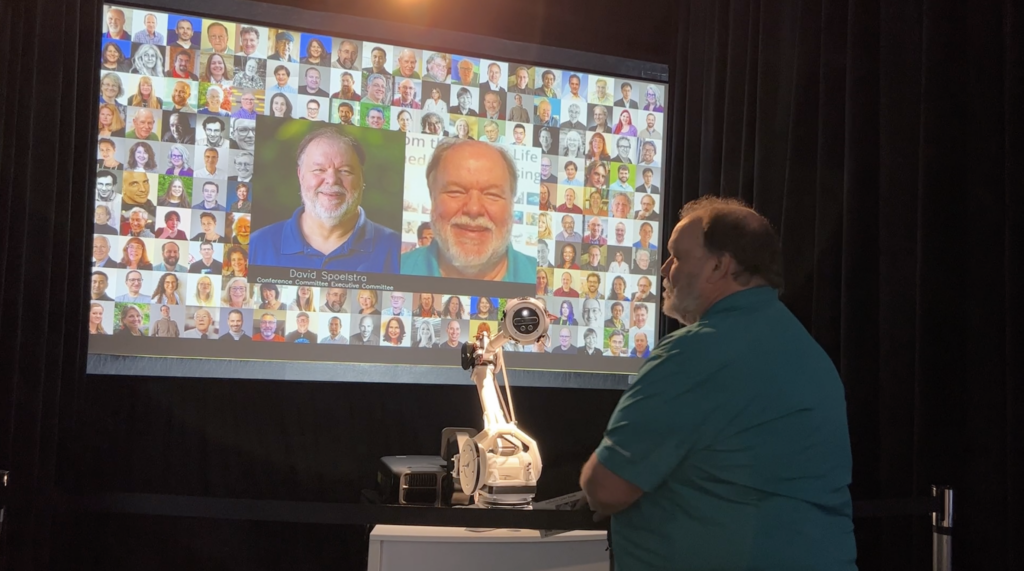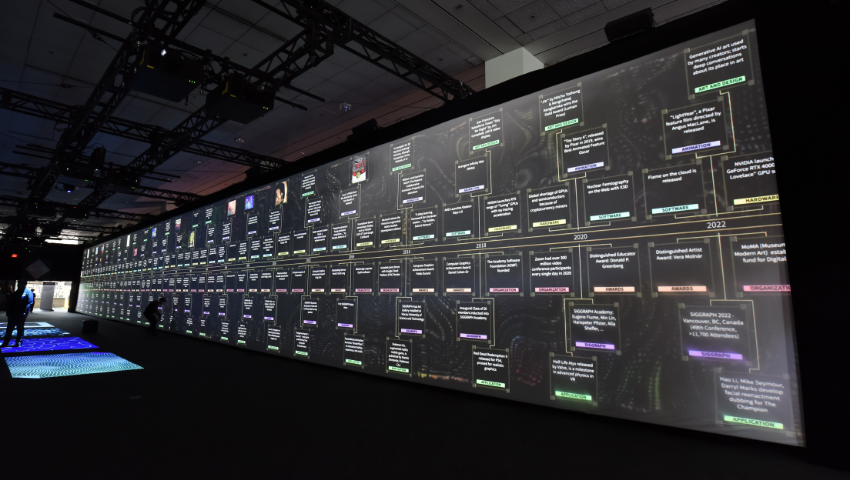Image credit: photo by John Fujii © 2023 ACM SIGGRAPH
Take a walk down memory lane and immerse yourself in a visual journey like no other. This year, SIGGRAPH debuted the SIGGRAPH 2023 History Time Tunnel, featuring the most comprehensive timeline of computer graphics achievements over the past 50 years. To get a behind-the-scenes look into the creation of the Time Tunnel, SIGGRAPH sat down with SIGGRAPH 2023 History Chair Bonnie Mitchell to walk us through the inspiration, challenges, and selection process.
SIGGRAPH: What inspired the SIGGRAPH 2023 History Time Tunnel? Were there any similar projects that influenced the development and final product?
Bonnie Mitchell (BM): I am in charge of the SIGGRAPH physical archive, and I wanted to use the materials in this collection to celebrate the past 50 years of the SIGGRAPH conference. As a digital artist who develops physically immersive, interactive environments, I knew that the best way for the SIGGRAPH audience to engage with the history of this organization was to surround them with artifacts, images, and information. I wanted to create an experience that merged ideas related to the future with artifacts and images from the past. Visitors entered the Time Tunnel and encountered a robot built by Yamin Xu for SIGGRAPH’s 50th conference. The robot took pictures of participants and, using AI, matched them up with photos of volunteers, award winners, pioneers, and other community members in hopes of introducing participants to the people who made SIGGRAPH what it is today. Across from that was the “Postcards From the Future” developed by Patrick Lichty, which was inspired by En L’An 2000. Instead of inviting artists, we asked AI to envision what the future would look like in 50 years. We included one postcard illustrated by a human and asked people to guess which one it was.
The immersive tunnel was inspired by an installation I created years ago called “Inhabitants.” The projections on the walls were created by a large team of contributors from a variety of institutions. Nearly 40 computer graphics pioneers and other community members met via Zoom and developed the “Computer Graphics Timeline.” Ryan Laney took all the timeline entries and algorithmically produced a visual experience that was projected onto the 130 x 14-foot-long walls and showcased 50 years of accomplishments. The inspiration came from the interactive timelines I created for McGraw-Hill in the early 2000s. I have always been fascinated with how sequentially organized information can reveal so many interesting connections. Kon Hyong Kim (Kenny) and Graham Wakefield used images from the SIGGRAPH archive and created interactive wall projections that brought these memories to life. Weihao Qiu created an information visualization that illustrated the connections between Technical Papers in the archive through an analysis of the references. Interactive floor projections, created by Alexa Mahajan, Kon Hyong Kim, Eliot Feibush, and many more volunteers allowed people to use their bodies to alter the environment and catch photos of SIGGRAPH community members for points. Overall, there were far too many amazing people involved in the production of the Time Tunnel projections to mention here. In addition to the influences listed above, the “Submergence” installation by Squidsoup (Christa Sommerer and Laurent Mignonneau’s work showcased in the SIGGRAPH 2016 Art Gallery) and the EVL CAVE exhibited in 1992 were huge influences in my life.
SIGGRAPH: During the creation of the Time Tunnel, did you run into any challenges when trying to fit 50 years of innovation in just one place?
BM: I ran into lots of challenges! We spent a lot of time discussing ideas, and I wish we could have had more time to implement a few more ideas. Although it was a huge amount of work, it was magical to see what a group of people could do in such a short period of time. The development of the timeline began in January, but progress was slow, so we called on the Pioneers group to join in. That is when things really started happening.
There were numerous technical challenges, but nothing Kon Hyong Kim (Kenny), our team engineer, and our contractors could not handle. We had lots of meetings to ensure every little detail was worked out in advance. It is challenging managing large collaborative groups due to time, communications, and the massive amount of email that accrues. One interesting challenge occurred with the timeline. We had a lot more information than what would fit on the sides of the cubes, so we developed spinning cubes that could contain an infinite number of sides.

photo courtesy of Bonnie Mitchell
SIGGRAPH: How did you decide which projects and innovations would be selected?
BM: We had a call for participation; however, because it was a new program, not a lot of people submitted ideas or work. Although we received a few great submissions including Gordon Romney’s “First 3D Renderings” and Everardo Reyes’s information visualization posters (and more), most of the work was curated. I held meetings at SIGGRAPH 2022 and had several large Zoom meetings to solicit input from the community on what they would like to see at the 50th conference celebration. I made a list of the best and most feasible ideas, merged them with my own, and presented them to SIGGRAPH 2023 Conference Chair Erik Brunvand, who was very supportive. I gathered a team and worked closely with the History Committee. Dave Kasik from the History Committee took care of coordinating the team involved with the “Cabinets of Computer Graphics Curiosities.“ Mark Billinghurst coordinated the “Blasts From the Past” team, and I managed the other teams including the artifact displays (swag, posters, publication covers, T-shirt display) and curated content in the alcoves along with the Time Tunnel team. All ideas or projects selected or created needed to support the premise that SIGGRAPH’s 50th conference was going to be a celebration honoring the accomplishments of its community.
SIGGRAPH: What was your favorite part of the Time Tunnel? Additionally, did you have any favorite moments watching SIGGRAPH participants interact with the Time Tunnel?
BM: My favorite moment was in the early evening on Wednesday, 9 August, when the Time Tunnel was devoted entirely to the timeline, and nearly 100 participants showed up to view it. And they did not want to leave. It was a special screening honoring the volunteers who had worked so hard on it. Many of the SIGGRAPH 2023 participants wanted the timeline to stay on the screen longer so they could spend a lot of time perusing the entries. This gathering of participants included the pioneers and longtime SIGGRAPH members who were the developers, authors, artists, and researchers who created the computer graphics history that we were celebrating at the 50th conference.
I was also quite surprised to see people gathering around the robot and cheering when the robot matched the current photo it had taken of them with an older photo of themselves in the database when they were a volunteer or an award winner.
Step into the SIGGRAPH 2023 History Time Tunnel! Click here to watch a glimpse of computer graphics history from 1974 to the present.

Bonnie Mitchell is a new media artist and professor at Bowling Green State University in Digital Arts, in Bowling Green, Ohio. Mitchell is a member of the ACM SIGGRAPH History and Digital Arts Committee where she focuses on the development of their online archives and coordination of the SPARKS lecture series. She was the SIGGRAPH 2023 History Chair in charge of the immersive Time Tunnel, History Displays, and Retrospective Talks. Her current creative practice focuses on the development of physically immersive data visualization environments that showcase climate change over time. Mitchell’s artworks explore spatial and experiential relationships to our physical, social, cultural, and psychological environment through interaction, abstraction, and audio. She has created numerous abstract visual music installations and animations that have been shown in hundreds of venues worldwide. Mitchell is also a member of the ISEA International Advisory Committee and helps to direct their online archive and run the Summit on New Media Art Archiving.



